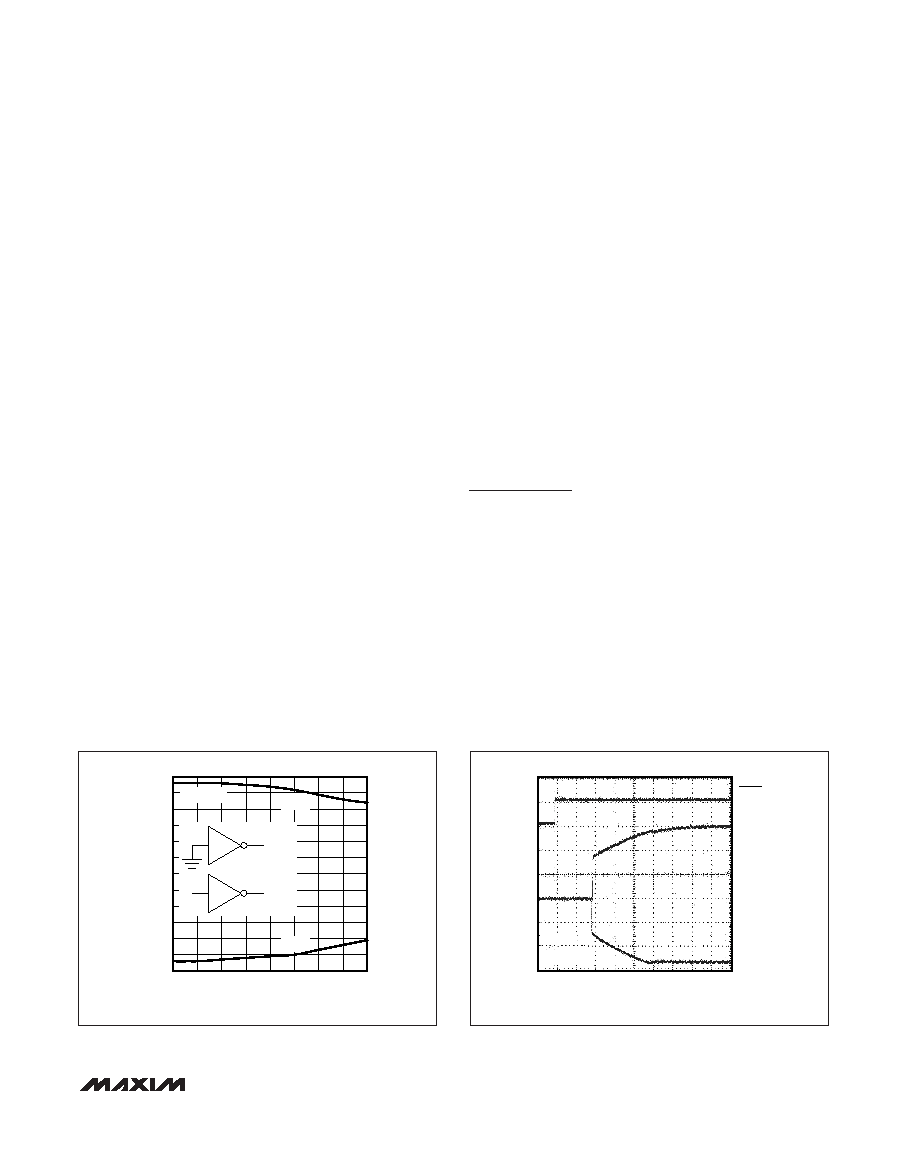- 您現(xiàn)在的位置:買(mǎi)賣(mài)IC網(wǎng) > PDF目錄9786 > MAX3250CAI+T (Maxim Integrated Products)IC TXRX RS-232 250KBPS 28-SSOP PDF資料下載
參數(shù)資料
| 型號(hào): | MAX3250CAI+T |
| 廠商: | Maxim Integrated Products |
| 文件頁(yè)數(shù): | 8/10頁(yè) |
| 文件大?。?/td> | 0K |
| 描述: | IC TXRX RS-232 250KBPS 28-SSOP |
| 產(chǎn)品培訓(xùn)模塊: | Lead (SnPb) Finish for COTS Obsolescence Mitigation Program |
| 標(biāo)準(zhǔn)包裝: | 2,000 |
| 類(lèi)型: | 收發(fā)器 |
| 驅(qū)動(dòng)器/接收器數(shù): | 2/2 |
| 規(guī)程: | RS232 |
| 電源電壓: | 3 V ~ 5.5 V |
| 安裝類(lèi)型: | 表面貼裝 |
| 封裝/外殼: | 28-SSOP(0.209",5.30mm 寬) |
| 供應(yīng)商設(shè)備封裝: | 28-SSOP |
| 包裝: | 帶卷 (TR) |

MAX3250
±50V Isolated, 3.0V to 5.5V,
250kbps, 2 TX/2 RX, RS-232 Transceiver
_______________________________________________________________________________________
7
AC waveforms are rectified on the isolated side of the
dual die to power its internal circuitry (ISOVCC).
Capacitor C6 filters the output of the rectifier. See the
Typical Operating Circuit.
The power controller works in a dual power mode. Power
is maximum when the isolated power supply is below its
regulation point. Power is reduced when the isolated
power supply is above its regulation point.
Dual Charge-Pump Voltage Converter
The RS-232 drivers are powered from a regulated dual
charge pump that provides output voltages of +5.5V (dou-
bling charge pump) and -5.5V (inverting charge pump)
relative to ISOCOM over the 3.0V to 5.5V VCC range.
The charge pumps are powered from ISOVCC and
operate in a discontinuous mode. If the output voltages
are less than 5.5V, the charge pumps are enabled. If
the output voltages exceed 5.5V, the charge pumps
are disabled. Each charge pump requires a flying
capacitor (C3, C4) and a reservoir capacitor (C7, C8)
to generate the V+ and V- supplies.
RS-232 Transmitters
The transmitters are inverting level translators that convert
TTL/CMOS-logic levels to ±5.0V EIA/TIA-232-compliant
levels. They guarantee a 250kbps data rate with worst-
case loads of 3k
in parallel with 1000pF to ISOCOM. In
shutdown, the transmitters are disabled and the outputs
are forced into a high-impedance state. When powered
off or shut down, the outputs can be driven up to ±12V
relative to ISOCOM. The transmitter inputs do not have
pullup resistors. All unused inputs should be connected
to VCC or GND.
RS-232 Receivers
The receivers convert RS-232 signals to CMOS-logic
output levels. The receivers’ outputs are forced into a
high-impedance state when the device is in shutdown.
This allows a single UART to multiplex between differ-
ent protocols.
Low-Power Shutdown Mode
Shutdown mode is obtained by driving SHDN low. In
shutdown, the devices typically draw only 20A of sup-
ply current and no power is transferred across the iso-
lation capacitors. The charge pumps are disabled, and
the receiver outputs and transmitter outputs are high
impedance. When exiting shutdown the charge pumps
and transmitter outputs are fully operational in typically
500s (Figure 3). Connect SHDN to VCC if the shut-
down mode is not used.
Applications Information
Power Isolation Capacitors
The values for capacitors C1 and C2 are important for
proper operation of the device. These capacitors
should be 0.047F for 4.5V to 5.5V operation, and
0.47F for 3.0V to 3.6V operation. Smaller values result
in insufficient supply voltage on the isolated side.
Larger values are not allowed.
Capacitor C9 provides an AC feedback path for proper
controller operation. Connect C9 from ISOCOM to GND.
The values for C1, C2, and C9 determine the maximum
frequency and amplitude of the voltage difference
between the local and isolated ground. Table 1 shows
proper capacitance values.
LOAD CURRENT PER TRANSMITTER (mA)
TRANSMITTER
OUTPUT
VOLTAGE
(V)
7
6
4
5
2
3
1
-5
-4
-3
-2
-1
0
1
2
3
4
5
6
-6
08
VCC = 3.0V
VOUT+
VOUT-
T1
T2
VCC
VOUT1+
VOUT2-
Figure 2. Transmitter Output Voltage vs. Load Current per
Transmitter
100
s/div
2V/div
T2OUT
VCC = 3.3V
SHDN
5V/div
T1OUT
Figure 3. Transmitter Outputs when Exiting Shutdown or
Powering Up
相關(guān)PDF資料 |
PDF描述 |
|---|---|
| SN74ABT8952DWRE4 | IC SCAN TESST DEVICE 28-SOIC |
| MS27508E18B35PA | CONN RCPT 66POS BOX MNT W/PINS |
| MS27499E24A35S | CONN RCPT 128POS BOX MNT W/SCKT |
| VI-2N2-IU-F3 | CONVERTER MOD DC/DC 15V 200W |
| IL3285 | IC TXRX RS485 ISOLATED 16SOICW |
相關(guān)代理商/技術(shù)參數(shù) |
參數(shù)描述 |
|---|---|
| MAX3250EAI | 功能描述:RS-232接口集成電路 RoHS:否 制造商:Exar 數(shù)據(jù)速率:52 Mbps 工作電源電壓:5 V 電源電流:300 mA 工作溫度范圍:- 40 C to + 85 C 安裝風(fēng)格:SMD/SMT 封裝 / 箱體:LQFP-100 封裝: |
| MAX3250EAI+ | 功能描述:RS-232接口集成電路 3-5.5V 250kbps Transceiver RoHS:否 制造商:Exar 數(shù)據(jù)速率:52 Mbps 工作電源電壓:5 V 電源電流:300 mA 工作溫度范圍:- 40 C to + 85 C 安裝風(fēng)格:SMD/SMT 封裝 / 箱體:LQFP-100 封裝: |
| MAX3250EAI+ | 制造商:Maxim Integrated Products 功能描述:IC RS232 TRANSCEIVER 250KBPS 5 |
| MAX3250EAI+T | 功能描述:RS-232接口集成電路 3-5.5V 250kbps Transceiver RoHS:否 制造商:Exar 數(shù)據(jù)速率:52 Mbps 工作電源電壓:5 V 電源電流:300 mA 工作溫度范圍:- 40 C to + 85 C 安裝風(fēng)格:SMD/SMT 封裝 / 箱體:LQFP-100 封裝: |
| MAX3250EAI-T | 功能描述:RS-232接口集成電路 RoHS:否 制造商:Exar 數(shù)據(jù)速率:52 Mbps 工作電源電壓:5 V 電源電流:300 mA 工作溫度范圍:- 40 C to + 85 C 安裝風(fēng)格:SMD/SMT 封裝 / 箱體:LQFP-100 封裝: |
發(fā)布緊急采購(gòu),3分鐘左右您將得到回復(fù)。